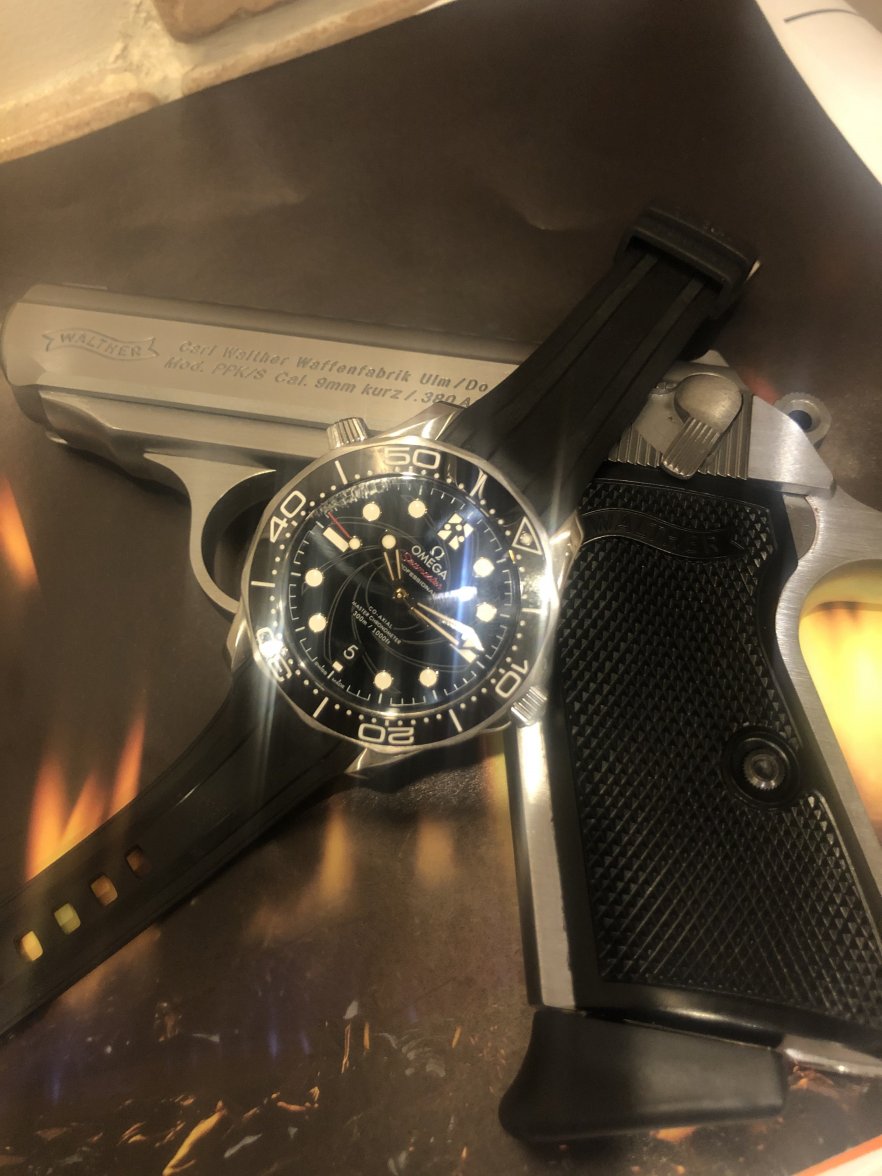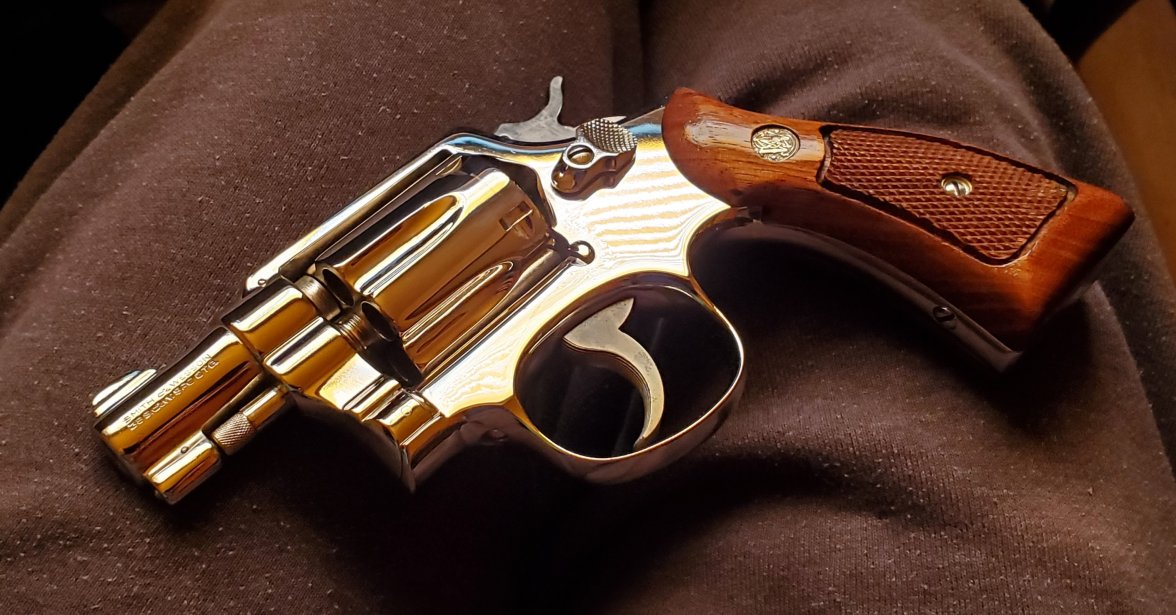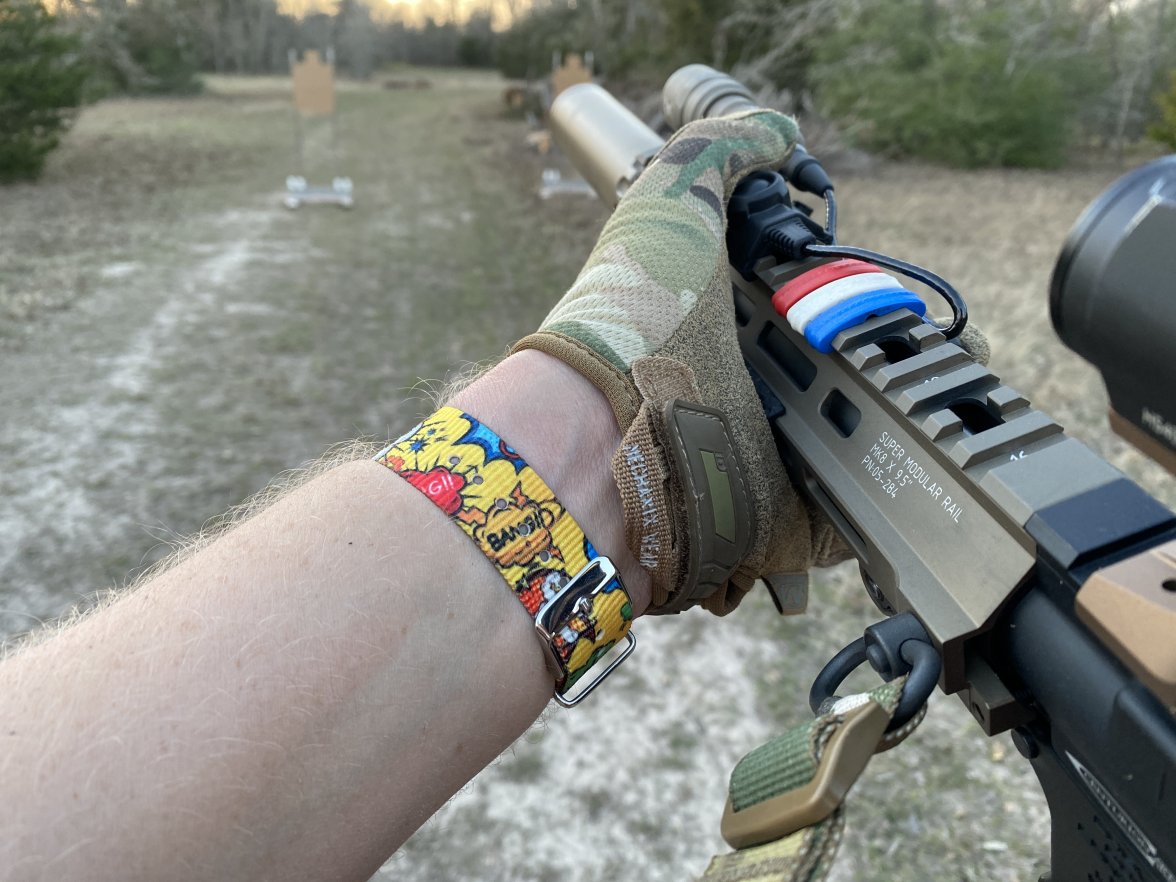So... any of our members here have an interest in firearms?
noelekal
··Home For Wayward WatchesA quick update photo of the 1911 tribe with the addition of the .455. Not implying that everyone should be so stubbornly narrow minded as I am and use only Colt brand pistols, but I enjoy owning and using only the original rather than clone brands or customs. If allowed to serve Colt can accomplish all reasonable 1911-gun needs without fuss or needless expense. There's one stinker of a non Colt in the bunch here, but its a wartime contract pistol so gets a pass. There are some wild and wacky calibers in here and all are factory guns. From oldest to newest (sort a').

Top: King Daddy of the 1911s, a Colt Model 1905 predecessor of the 1911 in .45 "Smokeless Rimless" (.45 ACP). This one has a late serial number so dates to about 1910.
Second row: Colt Government Model British Contract .455 from 1916, Colt Model 1911 .45 ACP from 1918, Remington Rand Model 1911A1 .45 ACP from 1944
Third row: Colt Government Model .45 ACP from 1947, Colt National Match .38 Special Mid Range from 1961, Colt Government Model .45 ACP from 1967, Colt Government Model 9mm Steyr from 1979
Forth Row: Colt Government Model 9mm from 1982 (out of order), Colt Gold Cup .45 ACP from 1979, Colt Service Ace .22 Long Rifle from 1983, Colt Government Model, Colt Government Model Enhanced 9X23 from 1997 (another out of order I see).
Fifth Row: Colt Government Model Enhanced .40 S&W from 1994, Colt Government Model .45 ACP from 2014, Colt Delta Elite 10mm from 2016, Colt Government Model .38 Super from 2020.
Actual "usin'" favorites: The 1967 Government Model .45, Gold Cup .45, 1983 Ace .22, Delta Elite 10mm, and the Government Model .38 Super.
The 9mm Government Model was a fun range gun for burning cheap factory 9mm for practice and plinking with no need to handload until this past year with the advent of a dearth of all ammunition. I can handload 9mm and have the components on hand, but am not fond of doing so.
Sentimental favorite: The 1918 Colt Model 1911 which was my first 1911 gun. Acquired in 1978.
The .45 ACP is the best caliber choice for the 1911 gun.

Top: King Daddy of the 1911s, a Colt Model 1905 predecessor of the 1911 in .45 "Smokeless Rimless" (.45 ACP). This one has a late serial number so dates to about 1910.
Second row: Colt Government Model British Contract .455 from 1916, Colt Model 1911 .45 ACP from 1918, Remington Rand Model 1911A1 .45 ACP from 1944
Third row: Colt Government Model .45 ACP from 1947, Colt National Match .38 Special Mid Range from 1961, Colt Government Model .45 ACP from 1967, Colt Government Model 9mm Steyr from 1979
Forth Row: Colt Government Model 9mm from 1982 (out of order), Colt Gold Cup .45 ACP from 1979, Colt Service Ace .22 Long Rifle from 1983, Colt Government Model, Colt Government Model Enhanced 9X23 from 1997 (another out of order I see).
Fifth Row: Colt Government Model Enhanced .40 S&W from 1994, Colt Government Model .45 ACP from 2014, Colt Delta Elite 10mm from 2016, Colt Government Model .38 Super from 2020.
Actual "usin'" favorites: The 1967 Government Model .45, Gold Cup .45, 1983 Ace .22, Delta Elite 10mm, and the Government Model .38 Super.
The 9mm Government Model was a fun range gun for burning cheap factory 9mm for practice and plinking with no need to handload until this past year with the advent of a dearth of all ammunition. I can handload 9mm and have the components on hand, but am not fond of doing so.
Sentimental favorite: The 1918 Colt Model 1911 which was my first 1911 gun. Acquired in 1978.
The .45 ACP is the best caliber choice for the 1911 gun.
Waltesefalcon
·A quick update photo of the 1911 tribe with the addition of the .455. Not implying that everyone should be so stubbornly narrow minded as I am and use only Colt brand pistols, but I enjoy owning and using only the original rather than clone brands or customs. If allowed to serve Colt can accomplish all reasonable 1911-gun needs without fuss or needless expense. There's one stinker of a non Colt in the bunch here, but its a wartime contract pistol so gets a pass. There are some wild and wacky calibers in here and all are factory guns. From oldest to newest (sort a').
Top: King Daddy of the 1911s, a Colt Model 1905 predecessor of the 1911 in .45 "Smokeless Rimless" (.45 ACP). This one has a late serial number so dates to about 1910.
Second row: Colt Government Model British Contract .455 from 1916, Colt Model 1911 .45 ACP from 1918, Remington Rand Model 1911A1 .45 ACP from 1944
Third row: Colt Government Model .45 ACP from 1947, Colt National Match .38 Special Mid Range from 1961, Colt Government Model .45 ACP from 1967, Colt Government Model 9mm Steyr from 1979
Forth Row: Colt Government Model 9mm from 1982 (out of order), Colt Gold Cup .45 ACP from 1979, Colt Service Ace .22 Long Rifle from 1983, Colt Government Model, Colt Government Model Enhanced 9X23 from 1997 (another out of order I see).
Fifth Row: Colt Government Model Enhanced .40 S&W from 1994, Colt Government Model .45 ACP from 2014, Colt Delta Elite 10mm from 2016, Colt Government Model .38 Super from 2020.
Actual "usin'" favorites: The 1967 Government Model .45, Gold Cup .45, 1983 Ace .22, Delta Elite 10mm, and the Government Model .38 Super.
The 9mm Government Model was a fun range gun for burning cheap factory 9mm for practice and plinking with no need to handload until this past year with the advent of a dearth of all ammunition. I can handload 9mm and have the components on hand, but am not fond of doing so.
Sentimental favorite: The 1918 Colt Model 1911 which was my first 1911 gun. Acquired in 1978.
The .45 ACP is the best caliber choice for the 1911 gun.
Will you adopt me?
The Father
·Will you adopt me?
I don't know, that level of collection almost reaches the level of a gun whore. Not that there is anything wrong it. Some of my best friends are whores of some type.
Professor
·Colt Government Model 9mm Steyr from 1979
France and Australia once used a cartridge based on the .303 British called the 7.7X54R.
The shoulder was set back and case OAL shortened. Enfield rifles were modified by setting the barrel back one thread and using a clean up reamer if necessary. A few semiauto 7.62 Nato rifles were turned into straight pull rifles and also chambered for this round for use as target rifles.
noelekal
··Home For Wayward WatchesThe Government Model 9mm Steyr was out of an order placed by an Italian distributor in the late 1970s. At the time Italian shooters could not on 9mm Parabellum as it is a military cartridge. 1100 pistols were produced, 1000 to be sent to the distributor in Italy for distribution in Italy with some going to Austria where the 9mm Steyr remained(s) popular. 100 were produced to be held for warranty work and spare parts. By 1983 the 100 pistols were assembled and sold state side. The European shipment bears Italian proof marks while the U. S. clean up production does not. The one I have was one of the 100 produced and it has no proof marks. I have a factory letter which states it was sold to a Massachusetts distributor in 1983.
It came to me as new unfired in the box. While it's a neato collectors' piece it isn't a sterling example of Colt craftsmanship. It's a Series 70 Mark IV which some Colt aficionados are beginning to revere as from a better age of Colt craftsmanship, yet the roll markings are poor, unevenly applied and it appears shop worn, almost as if the parts had rattled around in a bin for a while before being assembled into a complete pistol.
I have no doubt that it was unfired, but as I'm no purist collector and won't own a gun I won't shoot, I immediately gathered up quantities of 9mm Steyr and took it to the range and shot the hooey out of it. Poor Mrs. noelekal did duty chasing brass so that I could save it for future reloading efforts. Shoots nicely, feeling much the same as the 9mm Luger Government Model I already had.




It came to me as new unfired in the box. While it's a neato collectors' piece it isn't a sterling example of Colt craftsmanship. It's a Series 70 Mark IV which some Colt aficionados are beginning to revere as from a better age of Colt craftsmanship, yet the roll markings are poor, unevenly applied and it appears shop worn, almost as if the parts had rattled around in a bin for a while before being assembled into a complete pistol.
I have no doubt that it was unfired, but as I'm no purist collector and won't own a gun I won't shoot, I immediately gathered up quantities of 9mm Steyr and took it to the range and shot the hooey out of it. Poor Mrs. noelekal did duty chasing brass so that I could save it for future reloading efforts. Shoots nicely, feeling much the same as the 9mm Luger Government Model I already had.




Waltesefalcon
·The fact that you bought the 9mm Steyr is proof that you need to find a 30 Luger Commander.
noelekal
··Home For Wayward WatchesYeah, well ... I kept up with one or two at auction, but they went for so much money. Seemed too high.
Besides, the full sized Government Model is the size I admire most.
Besides, the full sized Government Model is the size I admire most.
SkunkPrince
·So I finally got around to taking a pic of my Bond Diver 300 with my PPK. Apologies to the Bond purists. We all know James Bond would never have used a stainless PPK. Too much risk of reflection. Still looks cool though!
noelekal
··Home For Wayward WatchesYou forgot to file off the front sight. 😁
I'm not that well versed on Bond. Did he wield his Walther sans front sight?
SkunkPrince
·I'm not that well versed on Bond. Did he wield his Walther sans front sight?
noelekal
··Home For Wayward WatchesHah!
That would have been pointless in more ways than one (catch the pun there?). A Beretta Model 418 .25 has such cramped ergonomics that there's not enough gun to even grasp much less "quick draw," so puny of cartridge that it couldn't begin to be depended on accomplish much in the accuracy department or to bring a positive outcome to an assailant's attack.
I once had Beretta Model 1919, an early .25 caliber rendition of the Model 418. Used it to shoot a coyote on an occasion from three yards away. It was what I had with me at the time. The coyote was seated on its haunches facing me from a thin screen of broom weeds. Saw the fur part in a puff as the bullet struck the coyote full in the chest. The coyote only eyed me balefully as it turned to run off.
I'm aware that Bond "upgraded" to the 7.65 Walther, which is still actually feeble cartridge for real gun fighting.
https://getyarn.io/yarn-clip/396a684a-13b0-4d9a-91e1-aeb7bfd8c0a0
It's a good thing for James Bond that he is fiction.
That would have been pointless in more ways than one (catch the pun there?). A Beretta Model 418 .25 has such cramped ergonomics that there's not enough gun to even grasp much less "quick draw," so puny of cartridge that it couldn't begin to be depended on accomplish much in the accuracy department or to bring a positive outcome to an assailant's attack.
I once had Beretta Model 1919, an early .25 caliber rendition of the Model 418. Used it to shoot a coyote on an occasion from three yards away. It was what I had with me at the time. The coyote was seated on its haunches facing me from a thin screen of broom weeds. Saw the fur part in a puff as the bullet struck the coyote full in the chest. The coyote only eyed me balefully as it turned to run off.
I'm aware that Bond "upgraded" to the 7.65 Walther, which is still actually feeble cartridge for real gun fighting.
https://getyarn.io/yarn-clip/396a684a-13b0-4d9a-91e1-aeb7bfd8c0a0
It's a good thing for James Bond that he is fiction.
SkunkPrince
·Still, any gun is better than no gun.
voere
·A quick update photo of the 1911 tribe with the addition of the .455. Not implying that everyone should be so stubbornly narrow minded as I am and use only Colt brand pistols, but I enjoy owning and using only the original rather than clone brands or customs. If allowed to serve Colt can accomplish all reasonable 1911-gun needs without fuss or needless expense. There's one stinker of a non Colt in the bunch here, but its a wartime contract pistol so gets a pass. There are some wild and wacky calibers in here and all are factory guns. From oldest to newest (sort a').
Top: King Daddy of the 1911s, a Colt Model 1905 predecessor of the 1911 in .45 "Smokeless Rimless" (.45 ACP). This one has a late serial number so dates to about 1910.
Second row: Colt Government Model British Contract .455 from 1916, Colt Model 1911 .45 ACP from 1918, Remington Rand Model 1911A1 .45 ACP from 1944
Third row: Colt Government Model .45 ACP from 1947, Colt National Match .38 Special Mid Range from 1961, Colt Government Model .45 ACP from 1967, Colt Government Model 9mm Steyr from 1979
Forth Row: Colt Government Model 9mm from 1982 (out of order), Colt Gold Cup .45 ACP from 1979, Colt Service Ace .22 Long Rifle from 1983, Colt Government Model, Colt Government Model Enhanced 9X23 from 1997 (another out of order I see).
Fifth Row: Colt Government Model Enhanced .40 S&W from 1994, Colt Government Model .45 ACP from 2014, Colt Delta Elite 10mm from 2016, Colt Government Model .38 Super from 2020.
Actual "usin'" favorites: The 1967 Government Model .45, Gold Cup .45, 1983 Ace .22, Delta Elite 10mm, and the Government Model .38 Super.
The 9mm Government Model was a fun range gun for burning cheap factory 9mm for practice and plinking with no need to handload until this past year with the advent of a dearth of all ammunition. I can handload 9mm and have the components on hand, but am not fond of doing so.
Sentimental favorite: The 1918 Colt Model 1911 which was my first 1911 gun. Acquired in 1978.
The .45 ACP is the best caliber choice for the 1911 gun.
voere
·noelekal
··Home For Wayward WatchesI won't be one to tell you that voere. I never set out to consider the .38 Special a favorite handgun cartridge, always thinking of myself as more of a .44 Special/.45 ACP kind of guy. Still, it's the .38 Special that sees most use here. Shot a .38 Special revolver for the first time in summer of 1968 when I was eleven. I've been joined-at-the-hip with the .38 Special since I got my first handgun when I was 18. As a field cartridge it's never let me down on anything large or small with good hits. It must be pointed out that a nuclear powered Magnum will be wholly inadequate with poor hits.
More .38 Special guns live here than handguns in any other chambering.
That nickel plated one you're showing us dates to the late 1940s to the mid-1950s. The "fishhook" hammer spur, known as Smith & Wesson's "Speed Hammer" is evidence of its age as is the cylinder stop screw above the front of the trigger guard.
Here's a scroungy blued version of the same revolver. This one dates to 1951. A bank loan customer of mine wanted to get it out of the house and intended to give it to me. To keep things above board and on the up and up (RICO act you understand) I traded him two concrete turtle yard ornaments I especially bought for him as he said he wanted them for his new swimming pool for which I had provided him a loan to build.
I'm guessing it was a lawman's long time companion from the holster wear patterns.

Mrs. noelekal particularly likes the way it handles and it comes out of the safe when I go out of town.
More .38 Special guns live here than handguns in any other chambering.
That nickel plated one you're showing us dates to the late 1940s to the mid-1950s. The "fishhook" hammer spur, known as Smith & Wesson's "Speed Hammer" is evidence of its age as is the cylinder stop screw above the front of the trigger guard.
Here's a scroungy blued version of the same revolver. This one dates to 1951. A bank loan customer of mine wanted to get it out of the house and intended to give it to me. To keep things above board and on the up and up (RICO act you understand) I traded him two concrete turtle yard ornaments I especially bought for him as he said he wanted them for his new swimming pool for which I had provided him a loan to build.
I'm guessing it was a lawman's long time companion from the holster wear patterns.

Mrs. noelekal particularly likes the way it handles and it comes out of the safe when I go out of town.
Professor
·I'm aware that Bond "upgraded" to the 7.65 Walther, which is still actually feeble cartridge for real gun fighting.
A .32 or even a .25 in the brain will end a fight very effectively.
In WW1 the French issued .32 auto pistols with large clips to the back up crews of their LMG squads. They figured a blizzard of little bullets would keep the German MG gunners heads down while reloading better than random rifle shots.
Since the Frogs were using the Chauchat the pistols were likely as effective as the LMG.
An excellent .32 auto I'd like to have is a Spanish made pistol seldom seen. A few have shown up marked with Hong Kong police markings.
This pistol is fair sized for a .32 and has a double row clip holding 22 cartridges. The muzzle of the barrel extends about 3/4 inch beyond the slide, so perfect for mounting a suppressor.
PS
It has been found that a small bullet hole in the heart muscle is often more deadly than a hole from a larger bore.
There is a tough sheath covering the heart. A small bullet leaves only a very small hole in the sheath and blood from the damaged muscle builds up between heart and sheath causing pressure that quickly stops the heart.
A larger wound lets the blood out. The heart muscle keeps beating despite large holes. In either case the victim is unlikely to survive without rapid medical intervention but when there's blood crushing the muscle they aren't as likely to live long enough for medical aide. Its also a much more delicate procedure to drain the blood and restart the heart.
The same can sort of small diameter wound to the chest can cause the lungs to collapse.
noelekal
··Home For Wayward WatchesIf .32 and .25 are better than larger than it follows that .12 and .15 are even more better, hah!




